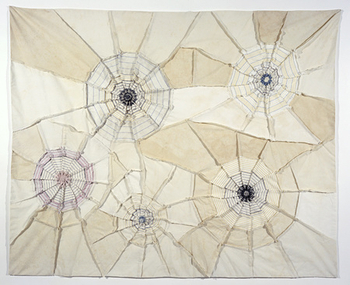
Untitled, Louise Bourgeois
Known for her enormous sculptures of spiders, many reproduced in Louise Bourgeois: The Spider and the Tapestries (Hatje Cantz), Bourgeois was never clear about what they meant to her. When asked directly, she replied, "Why the spider? Because my best friend was my mother and she was deliberate, clever, patient, soothing, reasonable, dainty, subtle, indispensable, neat, and as useful as a spider." Elsewhere she wrote, "To my taste, the spider is a little bit too fastidious. There is a very French, fiddly, overly rational, tricoteuse side to her, with her ever more precise and delicate invisible mending; she never tires of splitting hairs."
Caught in a web of fear.
The spider's web.
The deprived woman.
she once wrote in a poem which may hint at her relationship with her mother. From age eleven, Bourgeois was raised by a governess who was in truth her father's mistress, an unfortunate fact which led Bourgeois to hate her father and resent her mother for accepting the arrangement.
At other times she identified with the spider herself. "The female spider has a bad reputation," she wrote, "a stinger, a killer, I rehabilitate her. If I have to rehabilitate her it is because I feel criticized." This evokes the role of the spider in world mythologies, aligned with feminine danger.
"All my work in the past 50 years," she said, "all my subjects, have found their inspiration in my childhood. My childhood has never lost its magic, it never lost its mystery, and it never lost its drama." Her spiders possess a sense of enchantment, like fairy tale monsters magnified by a child's fears, little creatures now towering over us.
Bourgeois is no stranger to the magical qualities of sculpture. Her husband, Robert Goldwater, studied the relationship between Primitivism and Modernism. Bourgeois was influenced by African and Oceanic totems-not mere sculptures, but objects with occult powers. Her oversized spiders seem to have similar fearsome qualities.
Ultimately, her work is personal. She kept a journal all her life, and referred to her art as "another kind of diary." She believed the process of repetition exorcised the unconscious. Although she tried to keep a respectful distance from the totems which inspired her, careful not to appropriate another culture, she returned to a form of mystical repetition from her own tradition. "My work," she says, "is a confessional."
Support HuffPost
Our 2024 Coverage Needs You
Your Loyalty Means The World To Us
At HuffPost, we believe that everyone needs high-quality journalism, but we understand that not everyone can afford to pay for expensive news subscriptions. That is why we are committed to providing deeply reported, carefully fact-checked news that is freely accessible to everyone.
Whether you come to HuffPost for updates on the 2024 presidential race, hard-hitting investigations into critical issues facing our country today, or trending stories that make you laugh, we appreciate you. The truth is, news costs money to produce, and we are proud that we have never put our stories behind an expensive paywall.
Would you join us to help keep our stories free for all? Your contribution of as little as $2 will go a long way.
Can't afford to donate? Support HuffPost by creating a free account and log in while you read.
As Americans head to the polls in 2024, the very future of our country is at stake. At HuffPost, we believe that a free press is critical to creating well-informed voters. That's why our journalism is free for everyone, even though other newsrooms retreat behind expensive paywalls.
Our journalists will continue to cover the twists and turns during this historic presidential election. With your help, we'll bring you hard-hitting investigations, well-researched analysis and timely takes you can't find elsewhere. Reporting in this current political climate is a responsibility we do not take lightly, and we thank you for your support.
Contribute as little as $2 to keep our news free for all.
Can't afford to donate? Support HuffPost by creating a free account and log in while you read.
Dear HuffPost Reader
Thank you for your past contribution to HuffPost. We are sincerely grateful for readers like you who help us ensure that we can keep our journalism free for everyone.
The stakes are high this year, and our 2024 coverage could use continued support. Would you consider becoming a regular HuffPost contributor?
Dear HuffPost Reader
Thank you for your past contribution to HuffPost. We are sincerely grateful for readers like you who help us ensure that we can keep our journalism free for everyone.
The stakes are high this year, and our 2024 coverage could use continued support. If circumstances have changed since you last contributed, we hope you’ll consider contributing to HuffPost once more.
Already contributed? Log in to hide these messages.

